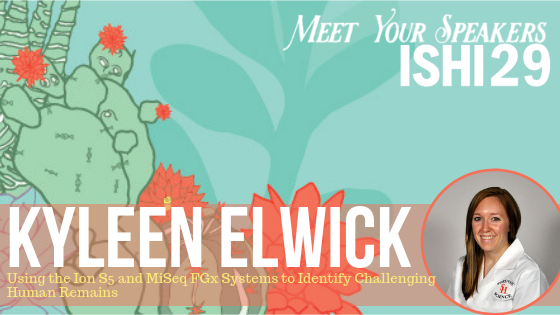Missing persons’ cases, unidentified human remains, and mass disasters are problems faced not only within the United States, but also many other countries worldwide. Routinely in missing persons’ cases, challenging skeletal remains (bone and teeth) are the only samples available for DNA analysis. However, some samples are more challenging to process than others because of their biological composition, environmental exposure (humidity, temperature, UV light, and microorganisms), DNA damage and/or degradation, the presence of inhibitors, and the possibility of contamination or comingled remains.
In her presentation at ISHI, Kyleen Elwick (Doctoral Candidate in Forensic Science, Sam Houston State University) will present on a study done which evaluates the comparative performance of the two most common forensic sequencing chemistries and platforms used within the community for identifying extremely challenging biological samples.
We sat down with Kyleen and asked her what her biggest learning was from doing this study.
Kyleen, thanks for chatting with us today! Can you tell us what types of samples you primarily work with in a missing person’s case?
The samples I primarily work with are bones, teeth, hair, and decomposed tissues.
Can you briefly describe the study that you’ll be presenting on at ISHI?
This study evaluates and compares the performance of the Ion S5 and MiSeq FGx systems using challenging human remains such as burned, embalmed, cremated, and decomposed bone and teeth samples.
Personally, what was the biggest learning that you took away from the project? How did you become involved?
I have learned how powerful massively parallel sequencing can be for challenging samples, but also how difficult and tedious the data analysis process can be, especially when working with multiple platforms and chemistries. My PI, Sheree Hughes-Stamm was awarded an NIJ grant 3 years ago and asked if I wanted to work on the project.
How did you become interested in forensic science?
I became interested in forensics when I was in high school. I participated in a program that showed high school students different career paths. One of our classes was a tour of the Kansas City Crime Lab and I was very fascinated after that visit. In college, I continued to take forensic science classes and familiarize myself with the subject until I applied to Sam Houston’s MSFS program and eventually continued on to the doctoral program.
What tips would you give to someone who is just starting out in the forensics field, or what is the best advice that you’ve received?
Definitely make connections and talk to everyone you can. Networking is awesome and could provide future job opportunities. Talking to vendors that have interesting products could start potential collaborations as well.
For those still deciding whether to attend, what is your favorite thing about ISHI, or what are you most looking forward to this year?
ISHI is an awesome conference and great all around experience! The talks are super niche to forensic genetics, but they are always interesting and provide a variety of topics. The off-site event is definitely the most fun though! The event site and entertainment is always above and beyond.
What’s one thing that others may not know about you?
I am graduating in December with my PhD and looking for a job! If you’re interested in my work you can hire me. 🙂 I am also an avid rock climber.
WOULD YOU LIKE TO SEE MORE ARTICLES LIKE THIS? SUBSCRIBE TO THE ISHI BLOG BELOW!
SUBSCRIBE NOW!


